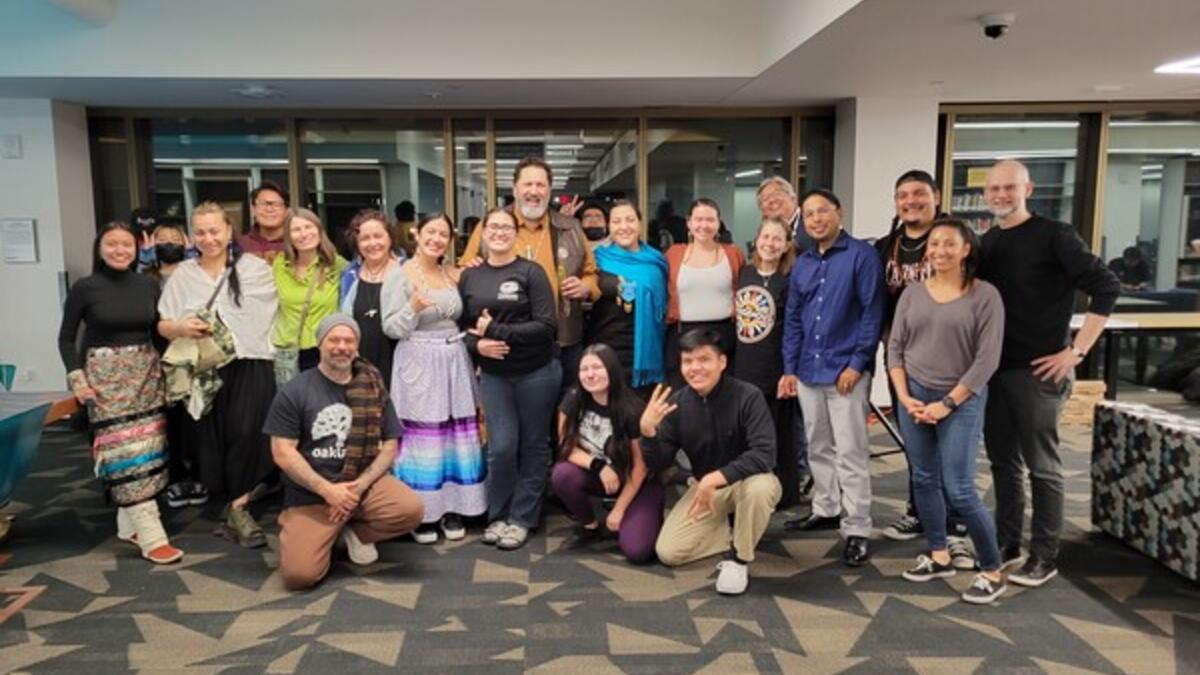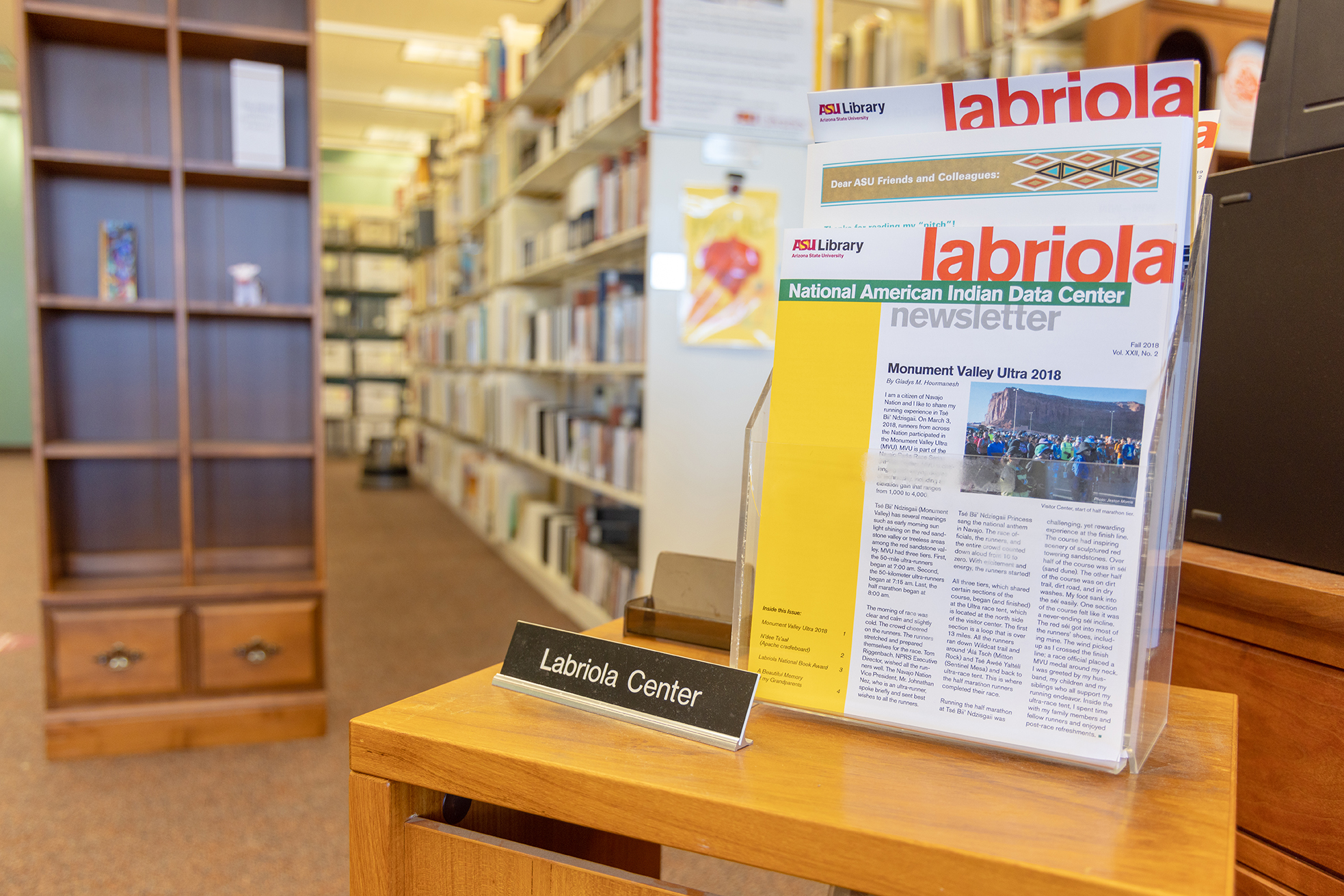Labriola National American Indian Data Center turns 30

Attendees pose at a Lo-Fi Study Session at Hayden Library in November 2022. Photo courtesy Labriola Center
On April 1, 1993, the Labriola National American Indian Data Center was created within the Arizona State University Library to serve as a national repository of Native American documents and materials and to provide access to this information through computer databases. Now in its 30th year, the Indigenous library has become an essential resource for the ASU community.
“From a collection of Indigenous books to an Indigenous knowledge zone within the library, the Labriola Center seeks to connect book smarts with Indigenous ways of knowing,” said Alexander Soto, director of the Labriola Center. “Through our physical spaces, research services, collections, programming and adherence to community stewardship and protocols, the Labriola Center is showing the impact that Indigenous libraries have for student success and community building.”
The center was made possible by the vision and generosity of Frank and Mary Labriola. Frank Labiola served as founder and chief executive of Pimalco (Pima Aluminum Company), one of the first major companies located on the Gila River Indian Community.
The Pimalco workforce consisted of members of the Gila River Indian Community. The Labriolas saw a need for an Indigenous library, and they proceeded to set aside funds and a scholarship for American Indian students at ASU.
“We owe gratitude to Frank and Mary Labriola for their generosity in underwriting the creation of the Labriola Center,” said Jacob Moore, associate vice president of tribal relations. “We recognize the Labriolas for giving back to tribal communities based on their personal longstanding relationship with the Gila River Indian Community.”
On the center’s dedication plaque, Frank and Mary Labriola wrote, “We would like to see the Labriola Center be an expression of our friendship and respect for the Indian people and a symbol of working together. It is our wish that the Labriola Center be a source of education and pride for all Native Americans."
“Thirty years later, that original vision came to fruition in ways that couldn’t have been imagined then,” Moore explained. “There were many people that came along to sustain this vision, including Joyce Martin, Peterson Zah, Simon J. Ortiz, and many other scholars and individuals who have contributed towards the rich collections that are respectfully curated by the center. With Jim O’Donnell’s guidance, Alex Soto and his team are poised to further expand the ways that the Labriola Center can serve American Indian students and tribal communities.”
Additional support for the center was later provided by the Alcoa Foundation and the National Education Association. As the only Indigenous-led library center within a doctoral research university in the United States, the Labriola Center celebrates and critically engages with American Indian and Indigenous scholarly works and creative writing.
Joyce Martin, associate librarian and head of the social sciences division team at the ASU Library, worked at the Labriola Center from 1999 until 2020 and experienced the impact of hosting Indigenous scholars and programs.
“I truly enjoyed working with the Simon Ortiz and Labriola Center Lecture on Indigenous Land, Culture and Community where I was able to meet many amazing scholars from across various disciplines, all of whom were friends with the remarkable Professor Simon Ortiz,” Martin said. “Professor Ortiz’s ideas tie so closely with the ASU Charter many years prior to the charter’s existence. The Labriola Center pushed the boundaries for public programming and student engagement, and this lecture series was just one of many examples.”
“Before I joined the Labriola, it was especially difficult to find community with other Native students in classes or around campus,” said ASU student and Labriola Center student archivist Lourdes Pereira. “As the Labriola has grown, it has also become a space where I can engage with other Indigenous students and receive that sense of community while being away from home.” Photo by Kyle Knox
The center in Hayden Library has hosted an array of events, from poetry readings to thesis defenses and student groups to film screenings. Highlights include hosting two Navajo Code Talkers with a traveling exhibit and establishing the Labriola Center American Indian National Book Award in 2008.
“Many amazing professionals worked in the Labriola Center as student employees. It is impossible for me to sum up how much I appreciate all the people I’ve met,” Martin said. “Thank you to all who allowed me to be a part of this amazing center, and I cannot wait to see what the next 30 years bring with Alex and his entire team.”
Building on this foundation, Soto was named the first Indigenous director in 2021 and expanded the center’s full-time personnel fourfold. This capacity has allowed the Labriola Center to enact Indigenous librarianship. The center has strengthened its success and engagement with students and the community, from events such as the Ribbon Skirt Workshops, Lo-Fi Study Sessions, Open Mic Nights and Knowledge from the Land series to a $1 million grant from the Mellon Foundation to support archival partnerships with tribal nations.
“We have opened up our library to be a community resource,” Soto said. “Notable collaborations include our partnership with Arizona Department of Education’s Office of Indian Education and Arizona Humanities to host the Changing the Narrative: K–12 Indigenous Literature and Literacy Symposium. We also partnered with Professor Melissa K. Nelson and (the Julie Ann Wrigley) Global Futures Laboratory for the Intercultural Well-Being: Indigenous Innovations and Design gathering. Our program coordinators, Eric Hardy and Yitazba Largo-Anderson do an incredible job at communicating how the Labriola Center cultivates spaces of healing and possibility for the Indigenous community at large."
The center has a long history of being a critical resource and support for ASU faculty and instructors, especially Indigenous scholars.
Myla Vicenti Carpio, director of graduate studies and associate professor of the American Indian Studies course, has seen enormous changes at the center throughout her time at ASU.
“When I first arrived at ASU, Labriola was a space primarily focused on archival collections and research,” Vicenti Carpio said. “Joyce moved the Labriola to a more welcoming, accessible and student-friendly library for all students, faculty and ASU Native events. I remember how Joyce generously opened up Labriola for various Indigenous poets, presentations and conference receptions.”
Vicenti Carpio recalled when Soto was an ASU student and how he worked to expand the possibilities of what a library could be.
“When Alex was a student in American Indian studies, I think we all saw his passion for Indigenous rights, sovereignty and culture,” Vicenti Carpio explained. “It is exciting to see how that passion and vision now gives rise to a true paradigm shift where a library center is built on a dynamic framework of Indigenous values and protocols, archival data sovereignty and Indigenous community partnerships.”
As technology continues to advance, libraries must play a critical role in Indigenous data sovereignty. Adding archivist Vina Begay to the team last year provides dedicated expertise to safeguard and steward Indigenous knowledge within higher education institutions.
“We need more Indigenous librarians and archivists — and allies — who will help our communities to navigate the increasingly complex world of data sovereignty and to better control and assert ownership over our own information,” said Michelle Hale, assistant professor of American Indian studies. “Alex has brought to the conversation important considerations about the ethical and responsible use of information by and about Indigenous communities; he works to foster awareness of the role of the university library as a good steward of Indigenous information, an important step in building and maintaining respectful relationships and trust between Indigenous communities and libraries. Labriola is a place where the Indigenous community can gather to share culture, and to be our Indigenous selves, through food, music, literature and art, and the exchange of ideas.”
Hale notes how the center has been a leader in building trust with Indigenous communities and helping people teach, learn and access information.
“For the scholarly community, Labriola is on the cutting edge of Indigenizing search tools, terminology and research methodology by working closely with scholars, listening to Indigenous communities and applying lessons from disciplines like American Indian studies,” Hale said. “Labriola ensures that Indigenous communities are not left behind. Instead, Indigenous communities are included and empowered in the university library of tomorrow.”
The meaningful library services the center provides from its all-Indigenous staff support the next generation of Indigenous excellence at the center’s spaces on the Tempe campus in Hayden Library and on the West campus.
Lourdes Pereira (Hia-Ced O'odham and Yoeme) was the first student archivist Soto hired when he joined the library and has worked in the Labriola Center for four years.
“Before I joined the Labriola, it was especially difficult to find community with other Native students in classes or around campus,” said Pereira. “As the Labriola has grown, it has also become a space where I can engage with other Indigenous students and receive that sense of community while being away from home.”
Pereira, who will graduate this spring, has also worked with the Community-Driven Archives Initiative to help her tribe, the Hia-Ced O’odham, gain federation recognition.
“Labriola has absolutely changed my life in unexpected ways and has given me a chance to help my community,” Pereira said. “I can’t imagine my life without ever getting the opportunity of working here, because I know for a fact I wouldn't be who I am today without it.”
With commencement approaching and another semester in the books, the team is ready to celebrate this milestone and envision the next 30 years.
“I am excited for the next chapter of Labriola’s history since we now have foundational staff and space to support the growing ASU Indigenous community,” Soto said. “We hope to push the definition of what a library can be for Indigenous peoples. We look forward to sharing more about our role at ASU and may even have a few surprises for the community. Stay tuned!”
More Arts, humanities and education

Local traffic boxes get a colorful makeover
A team of Arizona State University students recently helped transform bland, beige traffic boxes in Chandler into colorful works…

2 ASU professors, alumnus named 2025 Guggenheim Fellows
Two Arizona State University professors and a university alumnus have been named 2025 Guggenheim Fellows.Regents Professor Sir…

No argument: ASU-led project improves high school students' writing skills
Students in the freshman English class at Phoenix Trevor G. Browne High School often pop the question to teacher Rocio Rivas.No,…


